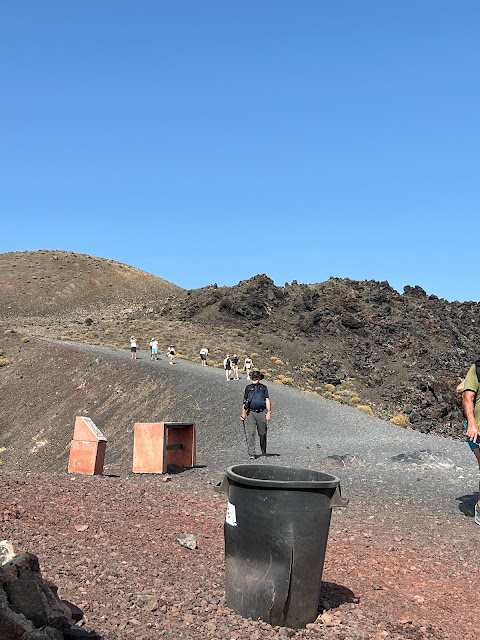
 |
| Nestled like a snowcap Fira, the capital of Santorini, sparkles in the sun |
Soaring up from the deep blue sea, the sheer volcanic cliffs of Santorini are topped with sparkling ‘snow’ – the gleaming white structures of its townships. It is breathtakingly beautiful. Diverting for a moment to a little geological history - Santorini is the southernmost island of the Cyclades in the Aegean Sea and is one of the five volcanic centres making up the southern Aegean volcanic arc. Its history started over 500,000 years ago when the northward movement of the oceanic segment of the African tectonic plate subducted under the Aegean part of the continental Eurasian plate. Interesting though it is (to me) that is all about the region's geomorphological history - for now!
 |
| 1984 Anne-Marie and Nathan riding donkeys up the cliff face |
 |
| Today in 2023 you can still ride donkeys but there is also cable car to the top |
For me, visiting here was a trip down memory lane – with a twist. Almost 40 years ago the children and I visited Santorini, this world-famous volcanic island, and from the clifftop gazed out over its drowned caldera. Rather than deal with the crush of tourists in that beautiful cliff city, however, on this visit Lindsay and I decided to explore the volcanoes in the Santorini caldera – Nea and Palea Kameni. To get a bit of a timescale on this, around 2000 BC a massive volcanic eruption devastated the island of Santorini (Thera). That catastrophic eruption blew out the island and the centre of the island sank creating a large crater where the sea rushed in and formed a beautiful bay, a flooded caldera. The eruption caused tsunamis which virtually wiped out the advanced Minoan Civilisation of Crete (Knossis), 100-odd Km to the south. I remember visiting the remains of Knossos in the 1980s and also watching the sun set over Santorini’s flooded caldera. What remains today of Santorini is a large crescent-shaped island enclosing a bay which they claim is the largest caldera on earth.
 |
| Those central lumps of land are the Kameni Islands |
Over the millennia since that huge eruption, there has been and still is volcanic activity in this same place probably from that original deep vent. This activity formed small lava islands called Kameni, meaning ‘burnt’. In the early C18 there were further eruptions inside the caldera and a new volcano emerged from the sea. Over time these small islands of volcanic origin merged and today we were to climb one of them, Nea (new) Kameni which is still active.
 |
| Sailing to the volcanic Kameni |
We were ferried across the bay in a rather lovely wooden yacht and disembarked on Nea Kameni. Then started a slow zigzagging climb up to the summit of the island (approaching 200m) passing a number of craters on the way. I conked out about halfway up while stalwart Lindsay struggled on. Was I disappointed? You bet, extremely, but I am learning to keep in mind that tomorrow is another day and there will be another climb or the like and I need to be able to move! From where I sat the view was stunning out over the caldera watching huge cruise ships sail in (which made me shudder). Lindsay eventually returned looking like he had climbed Mt Everest, poor thing (and he wasn’t the only one). It was a pretty hot day and the path was pretty challenging.
 |
| Mounds and walls of tumbled black lava were piled all around |
 |
| An old lavva flow |
 |
| My mountain goat returns! |
Once back on board we circumnavigated the island and its neighbour, Palea Kameni, before returning to the Santorini pier. It was a nostalgic and special day. I was happy.
 |
| People went swimming in the warm water bubbling up beside the island. |
 |
| A schematic of the Santorini volcano with the Kameni islands in the centre of the crater. |




















No comments:
Post a Comment